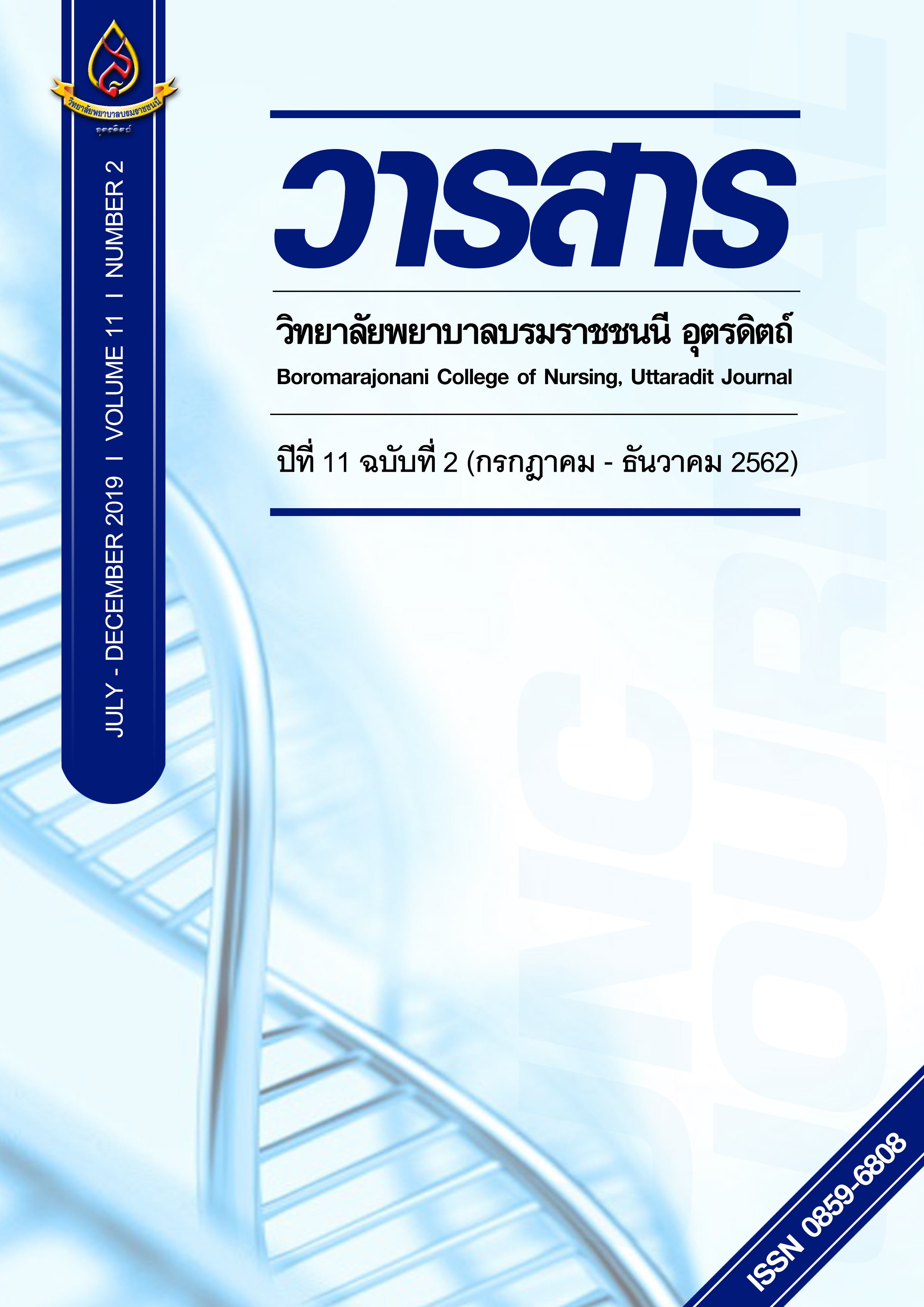เหตุผลทางปัญญา: แนวทางใหม่ของการฟื้นฟูหน้าที่บริหารจัดการสมองในผู้ได้รับบาดเจ็บสมอง
Main Article Content
บทคัดย่อ
ผู้ได้รับบาดเจ็บสมอง (Traumatic brain injury) มีการเสื่อมสภาพสมองทั้งโครงสร้างและหน้าที่ ขึ้นกับระดับความรุนแรงของการบาดเจ็บ การรับรู้ ความจำ ความใส่ใจ การตัดสินใจการใช้เหตุผล และการแสดงออกทางพฤติกรรม เป็นการเชื่อมโยงกระบวนการทางปัญญาซึ่งจะส่งผลต่อการดำรงชีวิตอย่างมีดุลภาพ แนวทางการฟื้นฟูหน้าที่บริหารจัดการสมอง จึงใช้การบูรณาการกิจกรรมประจำวัน ซึ่งกระบวนการประกอบด้วย การประเมินหน้าที่บริหารจัดการสมองโดยประยุกต์ใช้เครื่องมือที่สามารถประเมินได้ตามกิจกรรมที่ต้องการประเมิน การติดตามอาการทางสมองโดยการกระตุ้นการทำหน้าที่บริหารจัดการสมองอย่างมีเหตุผลรวมถึงการส่งเสริมให้มีการใช้กระบวนการทางปัญญาอย่างต่อเนื่องและมีเป้าหมาย เพื่อให้มีการแสดงออกทางพฤติกรรมอย่างเหมาะสม ดังนั้นการออกแบบกิจกรรมประจำวันสำคัญจึงต้องพิจารณาให้สอดคล้องกับบริบทของผู้ได้รับบาดเจ็บสมองแต่ละรายและผ่านการประเมินที่เป็นรายกรณี จะถือเป็นความสำเร็จของการฟื้นฟูหน้าที่บริหารจัดการสมองด้านการใช้เหตุผลและส่งผลให้เกิดดุลภาพชีวิตของผู้ได้รับบาดเจ็บสมอง
Article Details
บทความหรือข้อคิดเห็นใดใดที่ปรากฏในวารสารวิจัยการพยาบาลและวิทยาศาสตร์สุขภาพ เป็นวรรณกรรมของผู้เขียน ซึ่งบรรณาธิการหรือสมาคมศิษย์เก่า ไม่จำเป็นต้องเห็นด้วย และบทความที่ได้รับการตีพิมพ์เผยแพร่ถือเป็นลิขสิทธิ์ของวารสารวิจัยการพยาบาลและวิทยาศาสตร์สุขภาพ
References
2) Chapman, S. B., & Mudar, R.A.(2014). Enhancement of cognitive and neural functions through complex reasoning training: evidence from normal and clinical populations. Frontiers in systems neuroscience, 8,69.
3) Cicerone, K. D. et al., (2011). Evidence-based cognitive rehabilitation: updated review of the literature from 2003 through 2008. Archives of physical medicine and rehabilitation, 92(4), 519-530.
4) Corrigan, J. D., Selassie, A. W., & Orman, J. A. (2010). The epidemiology of traumatic brain injury. The Journal of Head Trauma Rehabilitation, 25(2), 72–80.
5) D’Esposito, M., & Gazzaley,A.(2006). Neurorehabilitation of executive function. Neural rehabilitation and repair, 475-487.
6) Downing, M., Bragge, P., & Ponsford, J. (2019). Cognitive rehabilitation following traumatic brain injury: a survey of current practice in Australia. Brain Impairment, 20(1), 24-36.
7) Freigang, C., Richter, N., Rubsamen, R., and Ludwig, A. A. (2015). Age-related changes in sound localisation ability. Cell and Tissue Research. 361, 371–386.
8) Herholz, S. C., & Zatorre, R. J. (2012). Musical training as a framework for brain plasticity: behavior, function, and structure. Neuron, 76(3), 486-502.
9) Julayanont, P., & Nasreddine, Z. S. (2017). Montreal Cognitive Assessment (MoCA): concept and clinical review. In Cognitive screening instruments (pp. 139-195). Springer, Cham.
10) Logsdon, A. F. et al., (2011). Role of microvascular disruption in brain damage from traumatic brain injury. Comprehensive Physiology, 5(3), 1147-1160.
11) Masel, B. E., & DeWitt, D. S. (2010). Traumatic Brain Injury: A disease process, not an event. Journal of Neurotrauma, 27(8), 1529–1540.
12) Marshall, S., Bayley, M., McCullagh, S., Velikonja, D., & Berrigan, L. (2012). Clinical practice guidelines for mild traumatic brain injury and persistent symptoms. Canadian Family Physician, 58(3), 257-267.
13) Organ, P. A. (2010). Exercise in schools can help children pay attention in The classroom. Journal Developmental Medicine and Child Neurology, 54-57.
14) Paungkate N. (2016). The effect of watching Thai short film on the attention span of adolescents: an event-related potentials study (Doctoral thesis). Burapha University, Chon Buri. (in Thai)
15) Ponsford, J., Sloan, S., & Snow, P. (2012). Traumaticbrain injury: Rehabilitation for everyday adaptive living (2nd ed.). New York, NY: Psychology Press.
16) Rutherford, G. W., & Corrigan, J. D. (2009). Long-term consequences of traumatic brain injury.
The Journal of Head Trauma Rehabilitation, 24(6), 421–423.
17) Simon DW, Mc Geachy MJ, Bayir H, Clark RS, Loane DJ, Kochanek PM (2017) The far-reaching scope of neuroinflammation after traumatic brain injury. Nature Review Neurology 13, 171-191.
18) Talsma, D., Senkowski, D., Soto-Faraco, S., and Woldorff, M. G. (2010). The multifaceted interplay between attention and multisensory integration. Trends in Cognitive Sciences. 14, 400–410.
19) Teasdale, G., Maas, A., Lecky, F., Manley, G., Stocchetti, N., & Murray, G. (2014). The Glasgow Coma Scale at 40 years: standing the test of time. The Lancet Neurology, 13(8), 844-854.
20) Togher,L.,Wiseman-Hakes,C.,Douglas,J.,Stergiou-Kita,M.,Ponsford,J.,Teasell,R.,...&Turkstra,L.S. (2014). INCOG recommendations for management of cognition following traumatic brain injury, part IV: Cognitive communication. The Journal of head trauma rehabilitation, 29(4), 353-368
21) Vas, A. et al., (2016).Reasoning training in veteran and civilian traumatic brain injury with persistent mild impairment. Neuropsychological rehabilitation, 26(4),502-531.
22) Yang, W.,Guo,A.,Li, Y.,Qiu,J., & Ren,Y. (2018). Audio-visual spatiotemporal perceptual training enhances P300 component in healthy older adults. Frontiers in psychology, 9, 2537

